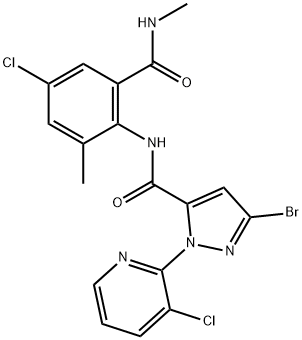ChemicalBook >?? ???? >????????
????????
|
|
???????? ??
- ???
- approximate 225℃ (dec.)
- ?? ?
- 526.6±50.0 °C(Predicted)
- ??
- 1.66±0.1 g/cm3(Predicted)
- ?? ??
- 2-8°C
- ???
- Chloroform: Slightly Soluble; DMSO: Slightly Soluble
- ??? ??
- ??
- ?? ?? (pKa)
- 10.19±0.70(Predicted)
- ??
- White to off-white
- LogP
- 3.641 (est)
- CAS ??????
- 500008-45-7
??
- ?? ? ?? ??
- ?? ? ???? ?? (GHS)
| ??? ?? | Xn | ||
|---|---|---|---|
| ?? ???? ?? | 22-36/37 | ||
| ????? | 26 | ||
| ?? ?? ??? | 500008-45-7(Hazardous Substances Data) |
???????? C??? ??, ??, ??
??
Chlorantraniliprole is an anthranilic diamide insecticide and agonist of ryanodine receptors located on the sarcoplasmic reticulum in muscle and endoplasmic reticulum in non-muscle cells. It binds to a different site than ryanodine on the receptor and stimulates the release of calcium from intracellular stores with EC50 values ranging from 40 to 50 nM for P. americana neurons and H. virescens or D. melanogaster recombinant ryanodine receptors. It is highly selective for insect over mammalian ryanodine receptors (EC50s = 14,000 nM, >100 μM, and >100 μM for C2C12 mouse, PC12 rat, and IMR32 human cells, respectively). Chlorantraniliprole is active against insects of the order Lepidoptera, including larvae of the fall armyworm (S. frugiperda), diamondback moth (P. xylostella), and tobacco budworm (H. virescens) with EC50 values of 0.02, 0.01, and 0.05 ppm, respectively, and of the orders Coleoptera, Diptera, and Isoptera. Formulations containing chlorantraniliprole have been used in agriculture to control moths, beetles, and caterpillars among other insects.??? ??
White crystal, specific gravity (for liquid) 1.507g/mL, melting point 208-210℃, decomposition temperature 330℃, vapor pressure (under 20~25) 6.3×1012Pa, solubility (under 20~25, mg/L): water 1.023, acetone 3.446, methanol 1.714, acetonitrile 0.711, ethyl acetate 1.144. Chlorfenvinphos It is highly efficient and broad-spectrum, and has good control effect on Lepidoptera of Noctuidae, stem borer moths, fruit moths, leaf roller moths, pink moths, vegetable moths, wheat moths, and fine moths, etc. It can also control Sphingidae weevils, leaf beetles; Diptera subterranean flies; sooty fly and many other non-lepidopteran pests.?? ??
Chlorantraniliprole was synthesized by reaction of 3-bromo-1-(3-chloropyridin-2-pyridinyl)-1H-pyrazole-5carboxylic acid with 2-amino-5-chloro-3-methylbenzoic acid.3-bromo-1-(3-chloropyridin-2-pyridinyl)-1H-pyrazole5-carboxylic acid was prepared by reaction of maleic anhydride with 2,3-dichloropyridine as starting materials in eight steps.2-Amino-5-chloro-3-methylbenzoic acid was prepared by reaction of 2-amino-3-methylbenzoic acid in one step.The structure of target compound was conf irmed by 1H NMR.Total yield was 36.3%(calculated with 2,3-dichloropyridine),and purity determined by HPLC was over 95%.??
ChEBI: Chlorantraniliprole is a carboxamide resulting from the formal condensation of the carboxylic acid group of 3-bromo-1-(3-chloropyridin-2-yl)-1H-pyrazole-5-carboxylic acid with the primary amino group of 2-amino-5-chloro-N,3-dimethylbenzamide. The first of the anthranilic diamide insecticides, it is a ryanodine receptor activator and is used to protect a wide variety of crops, including corn, cotton, grapes, rice and potatoes. It has a role as a ryanodine receptor agonist. It is an organobromine compound, a member of pyridines, a member of pyrazoles, a pyrazole insecticide, a member of monochlorobenzenes and a secondary carboxamide.???????? ?? ?? ? ???
???
4H-3,1-Benzoxazin-4-one, 2-[3-bromo-1-(3-chloro-2-pyridinyl)-1H-pyrazol-5-yl]-6-chloro-8-methyl-
5-Bromo-2-(3-chloro-pyridin-2-yl)-2H-pyrazole-3-carbonyl chloride
5-BROMO-2-(3-CHLORO-PYRIDIN-2-YL)-3,4-DIHYDRO-2H-PYRAZOLE-3-CARBOXYLIC ACID ETHYL ESTER
ETHYL 3-BROMO-1-(3-CHLOROPYRIDIN-2-YL)-1H-PYRAZOLE-5-CARBOXYLATE
3-BroMo-1-(3-chloropyridin-2-yl)-1H-pyrazole-5-carboxylic acid
?????
ETHYL 1-(3-CHLORO-2-PYRIDINYL)-3-PYRAZOLIDINONE-5-CARBOXYLATE
(3-CHLORO-PYRIDIN-2-YL)-HYDRAZINE
2H-3,1-Benzoxazine-2,4(1H)-dione, 6-chloro-8-methyl-
2-Amino-5-chloro-3-methylbenzoic acid
2,3-???????
3-Methylanthranilic acid
?? ??
???????? ?? ??
???( 38)?? ??
| ??? | ?? | ??? | ?? | ?? ? | ?? |
|---|---|---|---|---|---|
| Qingdao Trust Agri Chemical Co.,Ltd | +8613573296305 |
aroma@qdtrustagri.com | China | 301 | 58 |
| ATK CHEMICAL COMPANY LIMITED | +undefined-21-51877795 |
ivan@atkchemical.com | China | 32956 | 60 |
| TargetMol Chemicals Inc. | +1-781-999-5354 +1-00000000000 |
marketing@targetmol.com | United States | 32161 | 58 |
| Compound Net Biotechnology Inc. | +8615303909093 |
sales@compound-net.com | China | 2914 | 58 |
| Nanjing Sunlida Biological Technology Co., Ltd. | 025-57798810 |
sales@sunlidabio.com | China | 3239 | 55 |
| Shanghai Chaolan Chemical Technology Center | 021-QQ:65489617 15618227136 |
Sales@ATKchemical.com | China | 7298 | 58 |
| Hubei Zhengxingyuan Fine Chemical Co., Ltd. | 027-87879189 15207106154 |
3386829764@qq.com | China | 310 | 58 |
| Wuhan hongde yuexin pharmaceutical technology co. LTD | 027-83855391 13657260109 |
hbzlkschem2009@163.com | China | 4308 | 58 |
| Wuhan xinyangruihe Chemical Technology Co., Ltd. | 027-83850113 18171155316 |
2821856175@qq.com | China | 4723 | 58 |
| Jiangsu raspberry International Trade Co., Ltd. | 18507340638 |
2335663646@qq.com | China | 197 | 58 |







